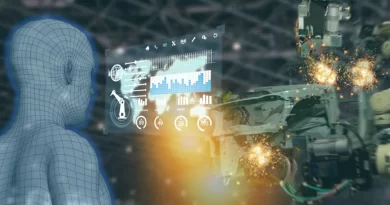The Evolution of Predictive Maintenance: How IoT and AI Are Revolutionizing Asset Management
The convergence of Internet of Things (IoT) and Artificial Intelligence (AI) technologies is transforming the field of maintenance. This article explores the impact of IoT and AI on predictive maintenance, how real-time data from IoT devices and AI-driven insights are optimizing maintenance schedules, reducing costs, and improving safety across various industries.
The maintenance landscape is undergoing a profound transformation, driven by the convergence of two powerful technologies: the Internet of Things (IoT) and Artificial Intelligence (AI). The integration of these cutting-edge solutions is reshaping predictive maintenance techniques, empowering businesses to adopt data-driven, proactive approaches to asset management. In this article, we explore the ways IoT and AI are revolutionizing predictive maintenance, their impact across various industries, and the potential benefits they offer to organizations.
IoT’s Impact on Predictive Techniques
The Internet of Things (IoT) has ushered in a new era of data collection and analysis, providing organizations with a wealth of information to optimize maintenance strategies. IoT-enabled devices, such as sensors and smart meters, continuously monitor equipment performance in real time. These devices are capable of measuring a wide range of parameters, including temperature, pressure, vibration, and energy consumption. According to a report by McKinsey & Company, IoT’s global economic impact is projected to reach between $3.9 trillion and $11.1 trillion per year by 2025.
By harnessing real-time data, organizations can detect potential issues before they escalate into costly failures. This shift from reactive to proactive maintenance strategies is a game-changer for businesses seeking to minimize downtime and improve overall operational efficiency. The continuous flow of data from IoT devices enables predictive maintenance, allowing organizations to anticipate when equipment is likely to fail and schedule maintenance more effectively.
Predictive maintenance techniques have been in use for some time, but the advent of IoT technology has significantly enhanced their accuracy and effectiveness. Traditional predictive maintenance approaches relied on historical data and scheduled maintenance at regular intervals. The problem with this approach was that it often led to unnecessary maintenance actions, resulting in increased costs and disruptions. Moreover, this approach couldn’t capture sudden changes in equipment behavior or detect issues that arose between scheduled maintenance intervals.
With IoT sensors providing real-time data, organizations can identify patterns and trends that may indicate impending equipment failure. This ability to monitor equipment continuously and collect vast amounts of data has greatly improved the accuracy of predictive maintenance models. According to a study published in the Journal of Manufacturing Systems, IoT-based predictive maintenance can achieve up to a 30% reduction in maintenance costs and a 70% decrease in breakdowns.
AI’s Role in Advancing Predictive Maintenance
Artificial Intelligence (AI) emerges as another critical enabler in the evolution of predictive maintenance techniques. AI-powered algorithms can analyze the data collected by IoT devices with unparalleled speed and accuracy. The use of AI in predictive maintenance has opened up new possibilities for analyzing complex data sets, identifying anomalies, and predicting equipment failure.
One of the key advantages of AI is its ability to learn from data. Machine learning, a subset of AI, enables predictive maintenance algorithms to continuously improve their performance as they process more data. The more data an AI-driven predictive maintenance system processes, the better it becomes at identifying potential issues and predicting when they are likely to occur.
Moreover, AI can adapt to changing operating conditions and equipment behavior. Traditional predictive maintenance models often struggled to handle dynamic environments, as they relied on fixed rules and assumptions. AI algorithms, on the other hand, can dynamically adjust their predictions based on real-time data, making them highly adaptable and effective in complex scenarios.
A case study by Deloitte demonstrated that companies adopting AI-driven predictive maintenance witnessed a 25% reduction in downtime and a 35% increase in equipment uptime. The ability of AI to process vast amounts of data quickly and accurately, coupled with its adaptability, has positioned it as a game-changer in the field of predictive maintenance.
Unleashing the Potential: The Combination of IoT and AI
The combination of IoT and AI technologies has unlocked a new realm of possibilities in predictive maintenance. These two technologies complement each other, addressing each other’s limitations and enhancing the overall effectiveness of predictive maintenance solutions.
IoT provides the data, while AI provides the intelligence to analyze and interpret that data effectively. By integrating IoT sensors and AI algorithms, organizations can build sophisticated predictive maintenance models that offer unprecedented insights into the health of their assets.
These integrated solutions can not only predict equipment failure but also identify the root causes of potential issues. This level of insight allows businesses to address maintenance problems proactively, leading to significant cost savings by avoiding unplanned downtime and extending the lifespan of assets.
According to a report by the World Economic Forum, predictive maintenance in manufacturing can lead to a 10% reduction in annual maintenance costs. The integration of IoT and AI technologies is a powerful tool for businesses to optimize maintenance schedules and achieve substantial savings.
Use Cases and Applications
Manufacturing Industry
In the manufacturing sector, IoT and AI are driving a paradigm shift in maintenance practices. IoT sensors integrated into production equipment constantly monitor its performance, capturing data on various parameters such as temperature, vibration, and energy consumption.
AI algorithms process this real-time data to identify patterns indicative of impending breakdowns or performance deviations. Manufacturers can then optimize their maintenance schedules and deploy maintenance teams proactively, reducing the risk of costly production halts and improving overall operational efficiency.
Transportation Sector
The transportation industry is another sector benefiting from predictive maintenance solutions driven by IoT and AI. Fleet management is a critical aspect of the transportation business, where timely maintenance is essential to ensure passenger safety and efficient cargo transportation.
Incorporating IoT sensors into vehicles and infrastructure allows transportation companies to monitor their fleets continuously. AI-powered predictive maintenance models analyze this data, providing insights into the condition of vehicles and predicting maintenance needs accurately. By addressing potential issues proactively, transportation companies can reduce maintenance costs and improve the safety and reliability of their services.
A case study by the Federal Transit Administration (FTA) revealed that predictive maintenance implementation in public transportation systems led to a 20% decrease in maintenance-related delays, resulting in increased passenger satisfaction and reduced operational costs.
Energy and Utilities
The energy and utilities sector also stands to gain from the integration of IoT and AI technologies into predictive maintenance practices. This industry relies on critical infrastructure, such as power plants and pipelines, which require continuous monitoring and maintenance.
IoT sensors deployed in these assets collect data on various parameters, such as temperature, pressure, and fluid flow. AI algorithms process this data to predict potential equipment failures and identify maintenance needs.
A study by the Electric Power Research Institute (EPRI) demonstrated that predictive maintenance can reduce the probability of equipment failure by up to 55%. By addressing maintenance issues proactively, the energy and utilities industry can ensure uninterrupted energy supply, reduce maintenance costs, and enhance safety and regulatory compliance.
Safety and Environmental Impact
Beyond the economic benefits, the integration of IoT and AI in predictive maintenance solutions brings significant safety and environmental advantages. By detecting potential equipment failures before they occur, organizations can prevent accidents and mitigate environmental incidents, aligning with regulatory requirements and safeguarding their reputation.
In the transportation sector, for instance, predictive maintenance helps identify potential safety risks in vehicles, ensuring the safety of passengers and drivers. For energy and utility companies, proactive maintenance reduces the risk of equipment failures that could lead to hazardous incidents, such as oil spills or gas leaks.
A study by the European Environment Agency (EEA) found that early detection and mitigation of environmental incidents through predictive maintenance can reduce the environmental impact of accidents by up to 90%.
The Future of Maintenance
The future of maintenance is undoubtedly predictive and data-driven, as businesses increasingly adopt IoT and AI technologies to optimize their asset management strategies. However, to fully realize the potential of these technologies, organizations must invest in the necessary infrastructure and develop the skills required to harness the power of IoT and AI-driven predictive maintenance solutions.
The convergence of IoT and AI technologies is redefining the way organizations approach maintenance and asset management. Predictive maintenance, enabled by real-time data from IoT devices and AI-driven insights, offers unparalleled opportunities to enhance operational efficiency, reduce costs, and improve safety across various industries.
By embracing these transformative technologies, businesses can shift from reactive to proactive maintenance practices, achieving significant savings through optimized maintenance schedules and extended asset lifespans. Moreover, the integration of IoT and AI empowers organizations to detect potential issues early, preventing accidents, and safeguarding the environment.
As the Fourth Industrial Revolution unfolds, predictive maintenance powered by IoT and AI is set to become a cornerstone of efficient and sustainable asset management, driving organizations towards a future of unprecedented data-driven insights and cost-effective operations.




